The complexity of Numismatics is underplayed. While people associate this term specifically with coinage, similar to any other field of study - numismatics is an interdisciplinary subject. The challenge begins with the discovery of a coin and persists till numismatists are satisfied with their research. While satisfaction is relative, it can be agreed that in such a field - there’s always more to the story. Numismatics links itself to disciplines such as history, archaeology, linguistics, metallurgy and more.
To add to the complexity of the subject, the extensive history of our country steps in. The geographical expanse of India does not make things easier for numismatists. If one was to research a coin from a specific time period, it would be important for them to keep a track of all the varieties of coins that appear around that time and location. The possibility of the coin traveling from another part of the world only increases the level of effort required to understand the origin of the coin in question. It is obvious that methods of research change with time and new discoveries may alter the “facts” that were previously known about a specific coin or system of coinage. We as readers have the privilege to overlook that effort and jump straight to facts- but we must not forget the dynamic nature of this field. While the method of understanding coinage is lengthy, one should also appreciate the information we obtain from such coinage. Understanding the shape, size, art, and significance helps apprehend the political, religious, cultural context of society.
In this article, I attempt to talk about coinage that appeared in India between 3rd century BCE and 5th century CE. During this period, several kingdoms, some big and some small, appeared on the political horizon and ruled for varying periods. While a lot of people are familiar with the popular empires such as the Mauryan empire, Kushans, the Cholas etc., the sheer amount of political entities present in this period is surprising. Some of these functioned parallel to each other, but similar to every empire in history- a decline was inevitable. Even though they declined, the material culture, among them coins, left behind by them have survived, furnishing information about the culture and history of those periods.
The following paragraphs outline the coinage of a few important ancient Indian empires
SATAVAHANA COINAGE
My first example of ancient coinage in India is from the Satavahana dynasty. Located in the Deccan region of the Indian subcontinent, this dynasty lasted nearly 300 years. It is said to be the earliest and largest Indian empire, south of the Vindhyas in ancient times. Many monarchs came and went out of power and a plethora of coins was yielded in the process.
Lead, copper, bronze, silver and potin are some of the metals that were used to make coinage in the Satavahana kingdom. The style of coinage used was not restricted to one style or shape either. Many rulers of this dynasty also issued silver coins with their image/representation. The language used on the coins was predominantly Prakrit and occasionally Dravidian. The large variety in their coinage suggests that the production of coins was not restricted to one time or location.
Symbology played a big role in Satavahana coinage. Symbols are not just aesthetically pleasing- they are also a method of expression, information and power. Initially, Satavahana coinage used symbols that were being used by the kingdom before it. This helps understand how the integration of states or regions may have impacted the material culture. While numismatists analysed symbols in these coins, they also noticed that engravings may contain religious affiliation. Some engraved devices even show that coins with a particular text /type may indicate the region of circulation. The most common figures and symbols seen in Satavahana coinage are Bull, elephant, horse, lion, ship, wheel, swastika, fish and conch, lotus, Ujjain symbol, etc.
An example of coinage being a symbol for power and dominance is the silver coin of Gautamiputra Satakarni overstruck on the coin of his rival the Saka Kshaharata ruler Nahapana. This coin shows the portrait of Nahapana and Greek inscription around it which are overstruck with symbols significant to the Satavahana empire - chaitya symbol or 3-peaked hill with a crescent above and river below, and traces of Gautamiputra’s Brahmi inscription around it. On the flipside, the original motifs of Nahapana’s coin, namely thunderbolt and arrow, and Brahmi and Kharoshthi inscriptions around it are still visible; on top of these is overstruck the so-called Ujjain symbol with pellets inside the orbs, one of the most common symbols seen on the Satavahana coins. This overstriking by Gautamiputra Satakarni was sending a loud and clear message to the general populace that he was the new political master.
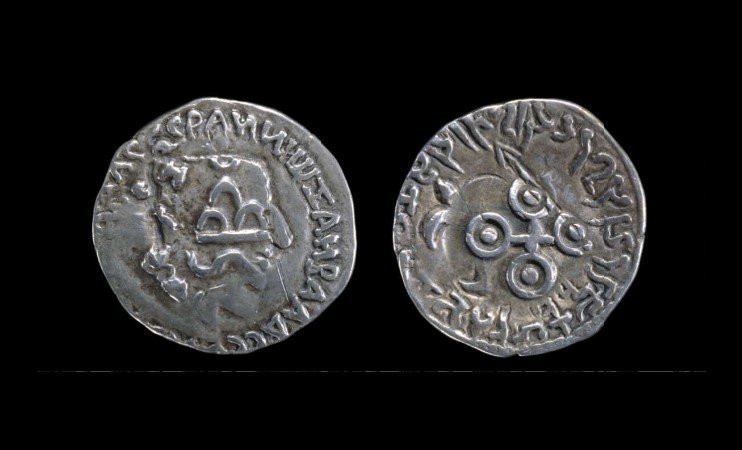
Silver coin of Gautamiputra Satakarni overstruck on Nahapana’s coin (The British Museum Images)
COINAGE IN THE KUSHAN EMPIRE
Starting in the Bactrian regions, the Kushan empire encompassed the northern flanks of the Indian subcontinent. Starting in the early century, it fragmented into semi-independent kingdoms by the 3rd century AD. The population of this empire was very diverse. During its lifetime, many languages, religions and cultures were practiced by the emperors and population. The Kushans were also known to have ties with the Roman empire, Sasanian Persia, the Han dynasty and the Aksumite empire.
Kushan coinage is one of the main sources to understand its political history.
Initially, the Kushans copied the coin designs of the Indo-Greek, Indo-Scythians and Indo-Parthians. Influenced by the Roman gold coins, they also started their own gold currency, and these were the first gold coins that were regularly issued in India. Besides gold coins, the Kushans issued copper coins in very large numbers. Coins were issued in several denominations. Languages such as Greek and Prakrit were used on Kushan coinage.
Kushan coins display a wide variety of deities. As mentioned before, the empire was known to have a range of religions and culture. The coinage seen throughout the empire consists of over 30 different gods. Most of the deities depicted are Iranian, but some Greek and Indian deities are also seen on the coins. Coins also portrayed emperors and had titles and sentences for context.
The coin seen below is a great example of Hellenistic influence of coinage. One of the Kushan clan chief’s (Heraios) portrait is seen on the front. This silver tetradrachm shows Heraios wearing a Greek royal headband. The flipside of the coin has engravings of the Greek goddess of victory (Nike), with Heraios atop a horse. The Greek lettering translates to “the tyrant Heraios sanav, of the kushans”. Some scholars attribute this coin type to Kujula Kadphises, the first major Kushan ruler.
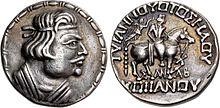
Heraios’s coin (wikipedia.com)
As mentioned earlier, the Kushans were the first to issue gold coins on a regular basis in India. Here is an example of a gold coin from the rule of Kanishka I, one of the most famous Kushan rulers. He ruled the Kushan dynasty in the second century. This gold coin has Kanishka displayed in the front with a Bactrian inscription written in Greek letters translating to – king of the kings, Kanishka the Kushan. The back of the coin contains a figure of Buddha (standing in Hellenistic style), with Greek script on the left translating to- “Boddo”. The detailing on this coin is exquisite. The coin is only 20 millimeters in diameter.
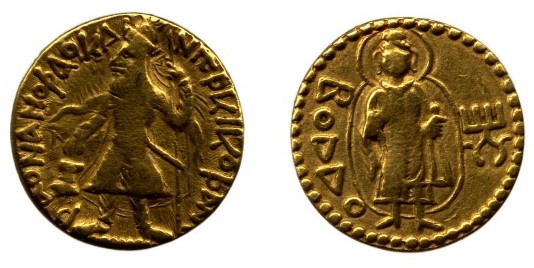
Kanishka’s coin (wikipedia.com)
Both the examples above help us understand the political power as well as religious inclination of the leaders.
The Kushans were followed by the Gupta dynasty in north India in c. 4th century and the Gupta gold coins were greatly influenced by the Kushan gold coinage; they were in fact initially modeled on the Kushan gold coins
COINAGE IN THE GUPTA EMPIRE
The Gupta empire dates back to 4th century CE. The empire started from a small state in the eastern state and then occupied large parts of the Indian subcontinent. This empire had many rulers, but Samudragupta, Chandragupta II and Kumaragupta I were significant as many cultural developments took place under them. The Gupta gold coin is known as dinara. Initially modeled on the Kushan gold coinage, soon Gupta coins developed its own individual features and styles. The coinage of this period are exquisite examples of art. Most of the coinage have the emperor and god or goddess doing a certain kind of ritual.
The earliest coins of the dynasty belonged to Chandragupta I, who introduced a currency system through gold coins. Under Samudragupta (Chandragupta I’s successor), 7 main types of coins like the Archer, Standard, Ashvamedha etc. were introduced. These type names signify what the engraving on the coinage depicted. The standard type shows the standing king with Gupta garuda standard, Archer type depicts the king with a bow and arrow, and Ashvamedha type outlines the ritual of “horse sacrifice”. Under Chandragupta II, some more types were issued though the archer type coins became most popular among the Gupta rulers. Silver coins were also introduced during the reign of Chandragupta II and continued by his successors. The Gupta emperors did not issue many copper coins, despite being common among other empires.
Most of the imagery on Gupta coinage revolved around celebrating the emperor and his valor. On some coins, the emperor holds a bow in one hand and arrow in the other, on some others he is shown holding a battle-axe or sword. On some others he is shown slaying a tiger or lion or rhinoceros and so on. Here is shown a coin of Kumaragupta I depicting him killing a lion.
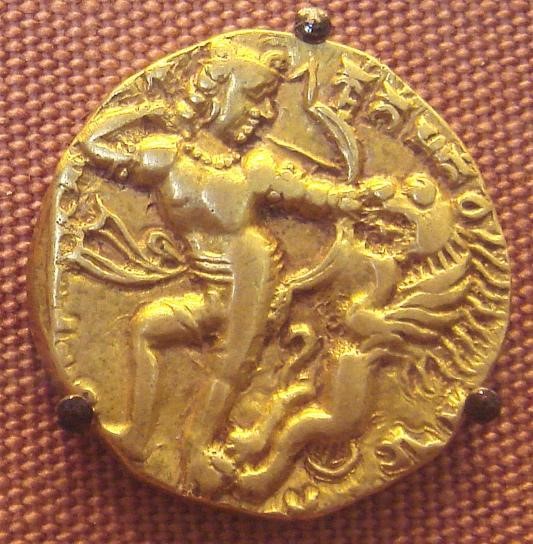
king kumaragupta killing a lion (wikipedia.com)
It is clear that coinage was also a medium of expression for the emperors to assert supremacy. An example that reiterates this point are the coins issued by Samudragupta and Kumaragupta I depicting Ashvamedha or Horse-sacrifice. This ritual entailed a monarch sacrificing a horse after an elaborate ritual to demonstrate political power. This was only conducted by a few kings in India, mostly by monarchs with immense wealth and power. The fact the two of the Gupta emperors portray this ritual on something as common as currency helps express their political dominance, influence and wealth. Some scholars believe that these coins were used as Daksinā to the priests that administered the sacrifice. Studies elaborate that this style may have started as Daksinā but was then distributed on a larger level eventually, as these are found in abundance all over north India.
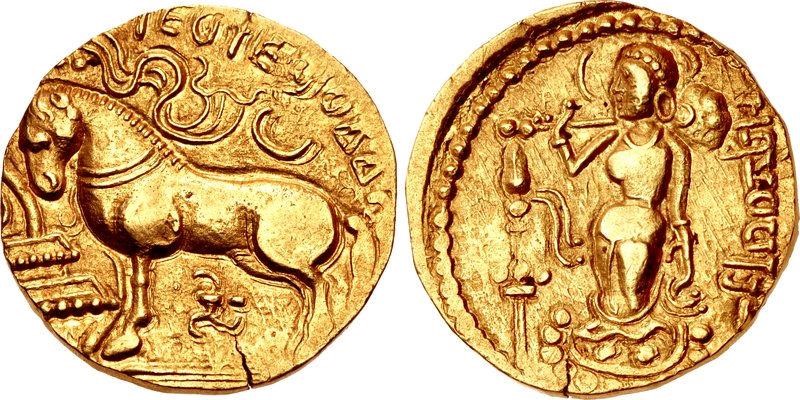
Ashvamedha type –coin of samudragupta (mintageworld.com)
CONCLUSION
It is clear that money runs the world. Being one of the most important aspects of ancient kingdoms, coinage was used as a medium for communicating religious beliefs, asserting political dominance and wealth. While barter may still have been in practice, the abundance of coins helps us understand that society took a step forward to what it is today. With the help of numismatists, we get to enjoy the rich culture of the ancient kingdoms. With important names and symbols on coinage (similar to coinage today) it can be established that the trends that began during this time did not die. Starting from inter-kingdom influence to establishing a pattern that lasted for centuries- the coinage definitely made an impact.
